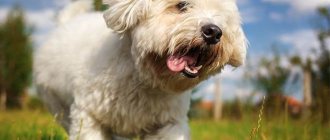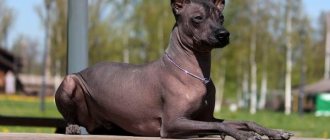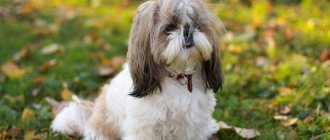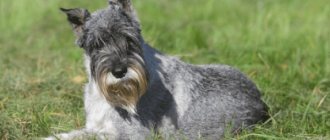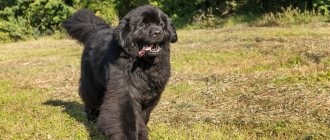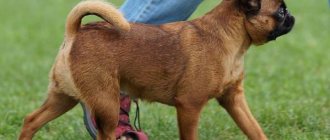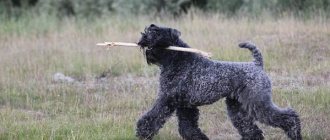Bolonki are a group of miniature dogs bred for decorative purposes. They are not suitable for home protection, but they attract with their appearance, extraordinary devotion and love for children. Due to the great popularity of the breed, you can find not only its official varieties on the market, but also many mestizos. If the last option is unacceptable to you, then be sure to study what a real lap dog looks like and what character it has - this will help you avoid being deceived by the seller.
Description and features
The homeland of this beautiful animal is Russia, or rather the Soviet Union. It was bred in the 50s of the 20th century. The Russian lapdog in the photo looks decorative, however, almost all breeds selected here have exclusively working purposes.
Initially, the dog was used to guard and transport cargo on carts. It’s amazing, but the gentle lapdog can even hunt, and does it with joy. She is devoid of bloodthirsty instincts, but the desire to catch prey appears if she needs to get the owner's approval.
For his sake, the dog is ready to do anything, even give his life. Boundless devotion to one person is its basic feature. The Russian lapdog becomes so attached to its owner that it can even die from melancholy if it faces a long separation from him.
Interest in breeding cute ornamental dogs appeared only after the end of World War II. At that time, on the territory of Russia, different miniature breeds of dogs were actively crossed in order to obtain a small, attractive-looking and, at the same time, efficient individual.
In those years, the demand for such animals was enormous. Women showed particular sympathy for them. The beauties of that time were pleased to go out into the world holding a fluffy and cute dog in their arms, radiating tenderness. They were noticed, loved and pampered.
The Russian lapdog is a good companion and friend. It is pleasant to interact with her, she helps to get rid of sadness and other negative emotions. In addition, the animal is very smart. It always understands if its owner is unhappy. But the owner’s joy will certainly make the dog happy and make him more cheerful.
The Russian lapdog becomes very attached to its owner and misses him greatly.
It’s hard to believe, but despite its miniature size, this breed is very hardy and strong. Its representatives can not only relax on upholstered furniture, but also quickly catch up with forest animals, take part in races and other competitions.
Such a pet will certainly brighten everyone's life. He is friendly, cheerful, gentle and loving, at the same time courageous, purposeful and fearless. Family safety is the animal's priority. It will not tolerate the presence of an intruder in the house and will definitely fight back.
Why is this done?
Attempts at crossing are usually called designer breeding of dogs - with a competent approach and knowledge of the basic laws, you can get quite interesting results. The results of the mixture are not suitable for exhibitions, but they have a rather interesting exterior, which contains features of both varieties. In addition, the character of a mixed breed from a Yorkie and, for example, a toy terrier, also combines the characteristics of both parents.
It is important to follow one of two rules:
- Crossing two purebred individuals;
- A union of two identical design crosses.
Crossing of different breeds is done to develop new designer breeds. As mentioned above, the main goal of designer breeding is the exterior of the future dog - a Yorkie and a toy terrier or Spitz provide a very interesting amount of external data.
In addition, in some cases, in this way they try to obtain mixed breeds with hypoallergenic properties for people who love dogs, but are allergic to them.
Let's also not discount the desire of some breeders to be known as pioneers - if you manage to get a new unique species, you can become famous and earn a lot of money. Although many dog breeders are quite skeptical about such an idea as crossing breeds.
Most dog breeders are quite skeptical about breed crossings.
Breed standard
This dog is compact, beautiful and very fluffy. Its body is oblong and square. The body posture is high and muscular. The chest moves forward slightly at the moment of movement. There is a slight bulge in the lower back.
The Russian lapdog has a small head and a pronounced muzzle. The nose is small and pigmented. According to the standard, if a dog is born with a light shade of fur, its nose has a similar color.
The dog's bite is correct. Her jaws are tightly closed. The teeth are tiny. The eyes are large and round. Most often, the color of the iris is brown. Eyes that are too protruding are considered a deviation. Also, they should not be planted deep.
The lapdog's ears are set high, have a clear triangular shape, and are narrowed upward. This is her “calling card”. The dog's ears are covered with long hair, which needs to be combed every day.
The animal's thighs are muscular and strong. This allows you to quickly push off from the ground. The limbs are stable and strong. The front ones are shorter than the rear ones. The pads of the feet are dark colored. The tail is rounded, located high on the lower back. Covered with fur along its entire length.
The main visual feature of the Russian lapdog breed is its thick fur. It is so beautiful that it even sparkles in the sun. According to the standard, it should be slightly wavy. Individuals with curly hair are not allowed to take part in competitions and exhibitions.
In addition, the dog has a dense undercoat. Almost any solid color is acceptable, except beige and white. Touching the thick fur of a lapdog is very pleasant. It feels like silk to the touch.
Rarely is a dog of this breed born purely black or brown. Usually, the price of such individuals is much higher. Regardless of the color of the fur, the dog may have light markings on its chest and ears.
Shih Tzu (Shorki)
The practice of mating Yorkshire terriers with Shih Tzus is also widespread, also aimed at producing designer puppies called Shorkies. These dogs are distinguished by their compact size, wide, pretty muzzle, body type, reminiscent of a Shih Tzu, and the color of a Yorkshire terrier. At the same time, some individuals may have spots of various shades on their fur.
Some sources note that Shorkie wool is hypoallergenic.
Character
The Russian lapdog simply cannot help but become everyone's favorite pet. She is so charming that she will melt the ice in the heart of even the most brutal person. She experiences tenderness for every living creature throughout her life. First of all, we recommend that large families get such a dog.
If children live in the house with the dog, you should know that every second, every family member will feel happy vibes. The interaction of a representative of this wonderful breed with small children can be called touching.
He is affectionate and sensitive with them. Under no circumstances will a lap dog harm a person, especially a small one. However, she is capable of feeling resentment. This is a vulnerable animal that needs the reverent attitude of all family members.
The Russian lapdog has a playful character
Rough treatment is unacceptable. Some dogs that have been hurt by people since childhood become overly suspicious and angry, but the lapdog does not. It is hard to bear resentment, but having experienced it once, he will not harbor a grudge. Melancholy and sadness are the emotions that an offended dog of this breed is prone to display.
The house where a Russian lap dog lives will never be calm and quiet. The dog is very playful and cheerful, she is always interested in spending time together with members of the household. She is attracted to chasing stuffed animals and some cat pranks.
For example, the animal will probably enjoy lying on the floor together, loud laughter and belly rubs. It cannot live a day without tactile contact. This is a very gentle and affectionate breed.
Yes, her appearance can be called “toy-like”. But this does not prevent her from being a strong dog capable of protecting her beloved family. Do not forget that she has the genes of guard dog breeds. Of course, the Russian lapdog is too small to neutralize an armed robber, but if she feels threatened, she will attack without hesitation!
The animal barks loudly only if it senses other dogs nearby. It is a mistake to think that this is how he expresses aggression. For dogs, barking is a means of communication. They communicate by making loud noises.
Such a pet can hardly be called uncontrollable and unbalanced. Usually, he grows up obedient. The dog's calm disposition is its main advantage. They often take lap dogs with them on visits, to social evenings, to shops, restaurants, and even to nature. Being in the arms of a familiar person, dogs will not panic and break free. They always rely on their owners, trusting them completely.
Energy and mobility are qualities that complement the list of distinctive features of representatives of this breed. You can take them with you for a run and even for swimming. Spending time with family members makes these animals happier.
It is believed that the Russian lap dog has a sixth sense and well-developed intuition. It accurately determines the current emotional state of a person, adapting to it if necessary. That is, if, in the dog’s opinion, its owner is upset about something, she will not carry him the ball and invite him to play, but will simply come closer and share his sadness with him.
Dachshund
A cross between a dachshund and a Yorkshire terrier (dorki) is the result of research carried out presumably at the end of the 20th century. breeding work in the USA. The choice fell on these dogs, since both of them belong to decorative and hunting breeds and are suitable for each other in size. Dorks are small rectangular dogs, weighing about 4 kg and reaching a height of more than 30 cm at the withers. They are similar in appearance to dachshunds, but have a wider muzzle and small, semi-erect, triangular-shaped ears.
Today, there are 2 varieties of these mestizos, differing from each other in coat. The first type has long, soft and slightly wavy hair, which is easy to comb and does not tend to bristle in different directions, making the dog look neat. The coat of the second variety is shorter and very hard; caring for it requires regular brushing only with metal brushes and haircuts at least twice a year.
Almost any coat color is allowed, but the most common is black and tan with a little gray.
The hunting blood of Dorks is the cause of some problems in their character:
- stubbornness and willfulness;
- jealousy of other pets;
- the need to dig holes;
- constant barking;
- hunting instinct aimed at small animals.
Any character flaws can be corrected with proper upbringing, socialization and training. In addition, Dorks need regular active walks and games, which help get rid of accumulated energy and extinguish the hunting instinct. Basic care for these pets consists of feeding them a high-calorie diet appropriate for their activity, daily cleaning of the ears and eyes, and trimming their nails as they grow back.
Kinds
There are several types of lap dogs. They are united by several parameters: miniature, friendliness and lush fur. Mostly women like to have such dogs. Let's consider the popular types of lapdogs, except Russian:
- Bichon Frize. The second name of the dog is “little lion”. These are small and very fluffy dogs that resemble stuffed animals. The Bichon Frize is a good decorative breed, perfect for apartment living.
- Havanskaya. This dog was bred by crossing other types from this group. He is small, has a pleasant appearance, very sweet and affectionate.
- Bolognese. The dog's homeland is France. She is considered the most sociable lap dog.
- Coton de Tulear. A very mischievous and nimble dog. He is filled with energy. The homeland of Coton de Tulear is the famous island of Madagascar.
- Maltese. One of the oldest representatives of this group of dogs. The Maltese is very fluffy.
- Levchen. The dog is very similar to a large Persian cat. He is just as graceful and fluffy. They cut it so that it resembles a decorative lion with a lush mane.
Maltese
The result of crossing Yorkshire terriers and Maltese dogs became Morkies or, as they are also called, Yorkties - affectionate, friendly and devoted designer puppies, characterized by high endurance and stamina. These dogs have a long, straight and silky coat, similar in color and texture to that of a Yorkie. Disadvantages include a tendency to early tooth loss, so it is necessary to carefully monitor the condition of your pet’s oral cavity, teaching them to hygiene procedures and brushing their teeth from a very early age.
Morkies are stubborn dogs and difficult to train. They are not suitable for people with a soft character - with such owners, Yorkies will feel like leaders of the “pack” and behave according to their status.
Care and maintenance
Living in a confined space will make absolutely any dog unhappy. A purebred dog should periodically leave its territory. This is necessary to gain new emotions and impressions.
The Russian lapdog is a classic “indoor” version of a pet. She does not require frequent walks, like, for example, a Chihuahua, and tolerates separation from household members, but not for long.
When leaving the apartment and leaving the dog alone, do not worry about the safety of household items. The lapdog will not spoil your shoes or tear up furniture with pillows. Usually, when left alone in the apartment, she lies down at the front door, waiting for the people dear to her to return. Rest assured, the arrival of a stranger in the house will definitely not be a reason for her to be warmly received.
Of course, if one of the family members is in the apartment at that moment, the animal will not attack the person who comes. This is how a dog’s intellectual potential is revealed. A smart dog always relies on the owner, that is, the arrival of a stranger for him is an event that a person must control.
To make the life of a Russian lap dog comfortable, you should purchase a lot of colorful soft toys for it. Brightly colored rubber animals, such as ducklings, work best. They are easy to find at any pet store.
Now about leaving. The Russian lap dog is unpretentious in this regard. But, she has a long, silky coat that should be brushed daily. We recommend using a metal comb. Some owners cut their dogs' hair in the summer to keep them cool. It makes sense. In this case, there is no need for daily combing.
Important ! If your Russian lap dog takes part in any competition or is shown at an exhibition, its coat requires additional care. We recommend using conditioner for decorative dogs along with shampoo.
Girls' lap dogs often have their hair braided, and I attach various hairpins to the hair. This way they look more attractive, but in this case you will have to comb their fur more often. Additional care points:
- Washing. Remove stains from your dog's eyes with a damp hand.
- Removing dental plaque. Since lap dogs have very small teeth, cleaning them is not easy. But, this must be done at least once a month.
- Grinding claws. Representatives of decorative dog breeds need to file or trim their claws, as they cannot cope with this task on their own.
- Removing sulfur. Every day, dust and dirt accumulate in the ears of animals, which should be removed in a timely manner. Otherwise, severe inflammation occurs.
Toy - terrier
Perhaps the most controversial mixes of Yorkshire terriers are the result of crossbreeding with toy terriers. By nature, these are active and independent dogs. The appearance of mestizos can be attractive or not. One can only judge with certainty the size of such dogs: Torques do not grow large, since their parents are representatives of small breeds of dogs.
As a rule, Torks have medium-length fur and not very thin paws, so they are liked by people who do not want to care for the long coat of Yorkshire terriers and who do not like Toys for their thin and slightly crooked limbs.
Nutrition
The duration and quality of your pet’s service depends on quality nutrition. In order for him to always remain healthy and beautiful, his body must regularly receive beneficial nutrients, from carbohydrates to plant extracts.
A Russian lapdog puppy should eat at least 100-150 grams of lean meat, such as chicken, every day. By the age of six months, its skeleton is formed and weight gain occurs. At this stage, it is important to lay the foundation of his health and immunity. Meat portions should alternate with dairy portions. Every lapdog needs such natural nutrition. In addition to the above, its menu may include:
- Borscht, soup.
- Lean fish.
- Cottage cheese, butter, sour cream.
- Chicken eggs.
- Broccoli, greens.
- Apples, bananas, strawberries.
- Non-acidic berries.
You should not experiment with your pet's menu. If the “wrong” food gets into his stomach, he risks getting sick. List of foods prohibited for lap dogs:
- Semi-finished meat products (for example, dumplings and pasties).
- Mayonnaise.
- Raw potatoes.
- Fatty meat (for example, pork).
- Peppery or salty dishes.
- Pasta.
- Sweets, including cream cakes.
It is better to feed a small lap dog frequently, at least 4 times a day. The number of meals is reduced gradually. An adult dog of this breed's bowl is filled with food twice a day. By the way, you can give your one-year-old pet dry food. But choose only a quality product!
How to choose a puppy?
- Look at the puppy's parents, so you can determine the possible development of the dog;
- You should not take lethargic and motionless puppies, most likely they are unhealthy;
- Observe the Chorkie during the game - how he communicates with his brothers, you will also see defects in the joints, if any;
- Play with the puppy yourself; if he is too excited and aggressive, it is better to choose another one;
- The wool should be clean, without tangles;
- Inspect your dog for ticks and fleas;
- Watch him eat;
- Check your eyes, mouth, and ears for any discharge.
Reproduction and lifespan
On average, this adorable dog lives for 14 years. With good care, its service life is extended to 1-2 years. Healthy, sexually mature and strong-looking Russian lap dogs are allowed to reproduce. The recommended age for breeding them is 2-3 years.
Before breeding animals, the breeder must make sure that they are not related. Otherwise, he will not get healthy puppies. So, mating occurs in the middle of the bitch’s estrus period, on days 3-5. The countdown should be carried out after the appearance of blood discharge.
Russian lapdogs are peace-loving dogs, so they rarely show hostility towards each other when meeting each other. But if the bitch doesn’t like something, she can push the male away. In this case, there is no need to force them on each other. It is better to postpone the mating for a couple of days.
Origin story
The breed is named after the Italian city of Bologna. In the Middle Ages, small dogs were used in aristocratic houses in various European countries. Their owners were noble women who got animals for decoration. This species of quadruped was one of the first to be used for decorative purposes.
Ordinary residents of European countries at that period of history were not interested in keeping such pets. They were interested in the dog’s skills and ability to work. The exact history of the origin of the lapdog is unknown; all types of the breed have their own theories. It is only known that breeding was carried out by breeders who wanted to please the royal and other noble families. Today lapdogs are common in many countries. The price of most varieties is affordable for many who want to have a pet.
Price
Having such a “living toy” at home is a great happiness. But, unfortunately, in Russia you can’t buy it in every city. Therefore, if you want to become the owner of a purebred Russian lap dog, you will have to go to the capital, that is, to Moscow, to get it.
It is in this city that there are 2 kennels where such dogs are professionally bred. There, the buyer will be provided with information about the health status of each puppy and will be helped to choose one. The price of a Russian lap dog from a nursery is 20-25 thousand rubles.
If you want to save money, you can use another method of purchasing - from your own hands. The cost of a puppy of this breed from breeders for 2022 is 8-15 thousand rubles. Individuals painted black or brown are considered rare, so they can be more expensive.
Owner reviews
It is difficult to find negative reviews about this dog breed on the Internet.
Ilya K. Gave his wife her dream for her birthday - a Bichon Frize. I'm delighted with her. Very smart dogs, ready to play day and night. They ride well in the car. By the way, it’s better to always take it with you. Otherwise, he will scream, bark and cry at home. Our girl is already 11 years old, in good health and still as active as a puppy.
Irina O. We promised our child a dog a long time ago. Everyone couldn't decide on the breed. We bought a Russian colored one. I didn’t even know that there was such a thing, but we were visiting and there we saw this miracle. Baby, but very smart. The wool is so nice! My child (9 years old) and I are best friends. He puts up with a lot from his son, but I make sure that they don’t offend each other.
Interesting Facts:
- The snow-white coat of lapdogs is the result of careful inbreeding. Red and black representatives of the breed lived on Melita. But for breeders, white color was a priority, so only white dogs were allowed for selection;
- lap dogs practically do not shed;
- lapdogs are excellent healers. The breed is often used in canistherapy;
- The most expensive Maltese dog cost 15 thousand dollars.
Education and socialization
The Russian lapdog is a sociable and peace-loving dog. She is upset by people's quarrels among themselves, their screams and hysterics. Therefore, it is important that a friendly atmosphere reigns in the apartment in which such a pet lives.
It is useless to teach a decorative dog strict guarding, ferocious hunting and observation. He will not be able to go against his nature. But teaching him circus tricks is quite easy.
Lapdogs are smart dogs, so even a child can handle their training. When you bring a small and cute dog into your home, show him a place where he can sit. When he approaches him, say clearly: “Place!” Repeat this command daily, and then your pet will remember it and will be able to leave the room at any time if circumstances so require.
If your pet tries to bite someone, even during play, do not let him do it. Say loudly: “Ugh!” Every pet dog must know this command, especially those who live in an apartment. Also, don't let her chew on pillows or furniture.
If you didn’t take care of your pet and he still chewed something, you should scold him for it, but don’t even think about using physical force! The Russian lapdog requires a tender and reverent attitude. She shouldn't feel pain. The best punishment for her is verbal.
You can train your dog to fetch a ball. Every time you throw it in front of you, say: “Fetch!” The game should be called “Where is the ball?” Every time you say these words, the mischievous dog will go in search of his favorite toy and bring it to you.
It should be noted that representatives of this breed do not need serious educational work. They are smart, obedient, and not prone to dominance. Such pets are a model of obedience and devotion. But, due to their strong attachment to their family members, they periodically act out when they are left alone at home.
By causing damage to household items, the dog tries to attract the owner’s attention and force him to stay at home next time. If your Russian lapdog is prone to this behavior, we recommend equipping him with a spacious playpen. Leave it there every time you plan to leave the apartment for a while.
Chihuahua mix (Chorki)
Chorkies are a mix of Chihuahuas and Yorkshire terriers. Their appearance is due to the widespread and high popularity of both breeds. They are small dogs with a compact, well-built body, a small head and erect ears. Their weight varies from 1.5 to 4 kg and depends on the body weight of both parents. The color of Yorkshire terriers is genetically stable, but the Chihuahua genes are most often responsible for the color of the Chorkie's coat, and it is impossible to predict what the puppy will be like.
As a rule, the coat of mixed breeds is golden or black, but dogs with fawn or black coats with white spots are also not uncommon. The length of the coat is also unknown in advance - a Chorkie may have a long coat and stubble on the face or medium-length hair, but most often in adult individuals the coat is long and straight. These dogs are characterized by high activity, friendliness, devotion to the owner and fearlessness.
They are smart, but very stubborn, which makes the training process very difficult. Therefore, raising and training a pet will require patience and perseverance. Among the breed's diseases are hypoglycemia and joint diseases, the average life expectancy is no more than 15 years.
In the professional literature, these dogs are also called Yorkie - Chi, Chia - Yorkie, Yorkie - Huahua.
Interesting Facts
The Maltipoo is captivating not only because of its attractive appearance. This small dog has many other advantages:
- Descendants of the Maltese and poodle are often used in canistherapy. The explanation is simple - these dogs are so positive and cheerful that they are ready to share their good mood with others at any time. This is especially important in the social adaptation of sick children who find true friends in the Maltipoo.
- Lapdog-poodle hybrids remain cheerful and very active until the end of their lives.
- In the USA you can find an advertisement for the sale of a mini maltipoo. Such puppies are also called teacup puppies, which indicates their size.
- These designer dogs are big gourmets. One of the Maltipoo's favorite treats is walnuts with honey.
And a few more interesting points about this little fluffy dog:
Possible diseases
Typical diseases that a Russian colored lapdog are related to the musculoskeletal system. The most popular among them are diseases of the spine. The owner must ensure that the pet is not high from the floor level. The dog may fall and get injured.
Ophthalmological diseases – tearing, entropion of the eyelids – cannot be excluded. It is better to collect bangs in a bun, pinning them with an elastic band. A popular orthodontic problem is tartar. It can be solved by regular brushing and special bones on which the dog sharpens its teeth and strengthens its gums.
In general, the pet is very resistant to illnesses. It's easy to explain. The breed was created spontaneously; there were many connections with mongrels. And they are famous for their excellent immunity. However, prevention in the form of healthy food, a balanced diet, and timely vaccines will not hurt.
Vaccinations are done three times in the first year of life: at two months, at three months, and also at six months. Then the dog is vaccinated annually at a certain period. With the help of vaccinations, you can prevent a number of dangerous diseases - rabies, leptospirosis, hepatitis, plague, etc.
Training
Raising a lapdog puppy is a responsible undertaking.
It is necessary to start from the very first day the baby arrives in the house. The main mistake made by owners of lap dogs is forgiveness. The lap dog must clearly understand the “No” command. Otherwise, the white sly one will become uncontrollable. Basic commands need to be taught as early as 2 months. It is better not to experiment with punishments : representatives of the breed react negatively to screams and violence, they can hide in corners and leave piles there. When raising lap dogs, it is better to be patient and actively praise them for successful actions, not forgetting about treats - such motivation will bring much more benefit than punishment: a lap dog is not a service dog after all.
It is better not to expect any special success in obedience from lap dogs - this is not the breed to obey commands without complaint. If the owner does not treat him with something tasty for successfully completing a task, the lapdog is sincerely indignant that he was deceived.
Particular attention should be paid to the “Come to me” command. A strict commanding tone and command is the only way to call a lap dog who is keen on research on a walk.
Professional courses are not what a lap dog needs. If you wish, you can pay attention to performing acrobatic tricks. Dancing and acrobatic performances performed by lap dogs are something! But learning will not be quick. It’s worth spending several months learning one number and preparing lots and lots of delicious food.
